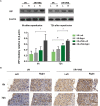Vagal Nerve Stimulation Attenuates Ischemia-Reperfusion Induced Retina Dysfunction in Acute Ocular Hypertension
- PMID: 30804746
- PMCID: PMC6378858
- DOI: 10.3389/fnins.2019.00087
Vagal Nerve Stimulation Attenuates Ischemia-Reperfusion Induced Retina Dysfunction in Acute Ocular Hypertension
Abstract
Purpose: The present study aimed to investigate whether cervical vagal nerve stimulation (VNS) could prevent retinal ganglion cell (RGC) loss and retinal dysfunction after ischemia/reperfusion (I/R) injury. Methods: First, rats were randomly divided into sham group (n = 4) and VNS group (n = 12). Activation of the nodose ganglia (NOG), nucleus of the solitary tract (NTS), superior salivatory nucleus (SSN), and pterygopalatine ganglion (PPG) neural circuit were evaluated by c-fos expression at 0 h after sham VNS and at 0 h (n = 4), 6 h (n = 4), 72 h (n = 4) after VNS. Secondly, rats were randomly assigned to I/R group (pressure-induced retinal ischemia for 1 h and reperfusion for 1 h in the right eye, n = 16) and I/R+VNS group (right cervical VNS for 2 h during the I/R period, n = 16). The left eye of each rat served as a control. Electroretinogram (ERG), RGC numbers, tumor necrosis factor-α (TNF-α) and vasoactive intestinal polypeptide (VIP) levels in retina were determined. Additionally, the level of VIP in PPG was evaluated. Results: In the first part of the study, compared with the sham group, the VNS group exhibited significantly increased expression of c-fos in NOG, NTS, SSN, and PPG tissues at 0, 6, and 72 h. In the second part of the study, compared with left eyes, retinal function in right eyes (as assessed by the a-wave, b-wave and the oscillatory potential amplitudes of ERG and RGC data) was significantly decreased by I/R. The decreased retinal function was attenuated by VNS. In addition, I/R induced an increase in inflammation, which was reflected by elevated TNF-α expression in the retina. VNS significantly attenuated the increase in I/R-induced inflammation. Moreover, VIP expression in the retina and PPG, which may contribute to the inhibition of the inflammatory response, was significantly increased after VNS. Conclusion: VNS could protect against retinal I/R injury by downregulating TNF-α. Upregulation of VIP expression due to activation of the NOG-NTS-SSN-PPG neural circuit may underlie to the protective effects of VNS.
Keywords: inflammation; ischemia/reperfusion; neuroprotection; retina; vagal nerve stimulation; vasoactive intestinal polypeptide.
Figures







Similar articles
-
Vagus nerve stimulation protects against acute liver injury induced by renal ischemia reperfusion via antioxidant stress and anti-inflammation.Biomed Pharmacother. 2019 Sep;117:109062. doi: 10.1016/j.biopha.2019.109062. Epub 2019 Jun 6. Biomed Pharmacother. 2019. PMID: 31177065
-
Vagus Nerve Stimulation Attenuates Acute Skeletal Muscle Injury Induced by Ischemia-Reperfusion in Rats.Oxid Med Cell Longev. 2019 Feb 28;2019:9208949. doi: 10.1155/2019/9208949. eCollection 2019. Oxid Med Cell Longev. 2019. PMID: 30944700 Free PMC article.
-
Vagus nerve stimulation exerts cardioprotection against myocardial ischemia/reperfusion injury predominantly through its efferent vagal fibers.Basic Res Cardiol. 2018 May 9;113(4):22. doi: 10.1007/s00395-018-0683-0. Basic Res Cardiol. 2018. PMID: 29744667
-
miR-210 mediates vagus nerve stimulation-induced antioxidant stress and anti-apoptosis reactions following cerebral ischemia/reperfusion injury in rats.J Neurochem. 2015 Jul;134(1):173-81. doi: 10.1111/jnc.13097. Epub 2015 Apr 8. J Neurochem. 2015. PMID: 25783636
-
[Nonarteritic ischemic optic neuropathy animal model and its treatment applications].Nippon Ganka Gakkai Zasshi. 2014 Apr;118(4):331-61. Nippon Ganka Gakkai Zasshi. 2014. PMID: 24864434 Review. Japanese.
Cited by
-
Auricular Transcutaneous Vagus Nerve Stimulation Acutely Modulates Brain Connectivity in Mice.Front Cell Neurosci. 2022 Apr 25;16:856855. doi: 10.3389/fncel.2022.856855. eCollection 2022. Front Cell Neurosci. 2022. PMID: 35548372 Free PMC article.
-
Neuroprotective Peptides in Retinal Disease.J Clin Med. 2019 Aug 1;8(8):1146. doi: 10.3390/jcm8081146. J Clin Med. 2019. PMID: 31374938 Free PMC article. Review.
-
Vagus Nerve Stimulation Ameliorates Renal Ischemia-Reperfusion Injury through Inhibiting NF-κB Activation and iNOS Protein Expression.Oxid Med Cell Longev. 2020 Feb 20;2020:7106525. doi: 10.1155/2020/7106525. eCollection 2020. Oxid Med Cell Longev. 2020. PMID: 32148655 Free PMC article.
References
LinkOut - more resources
Full Text Sources

